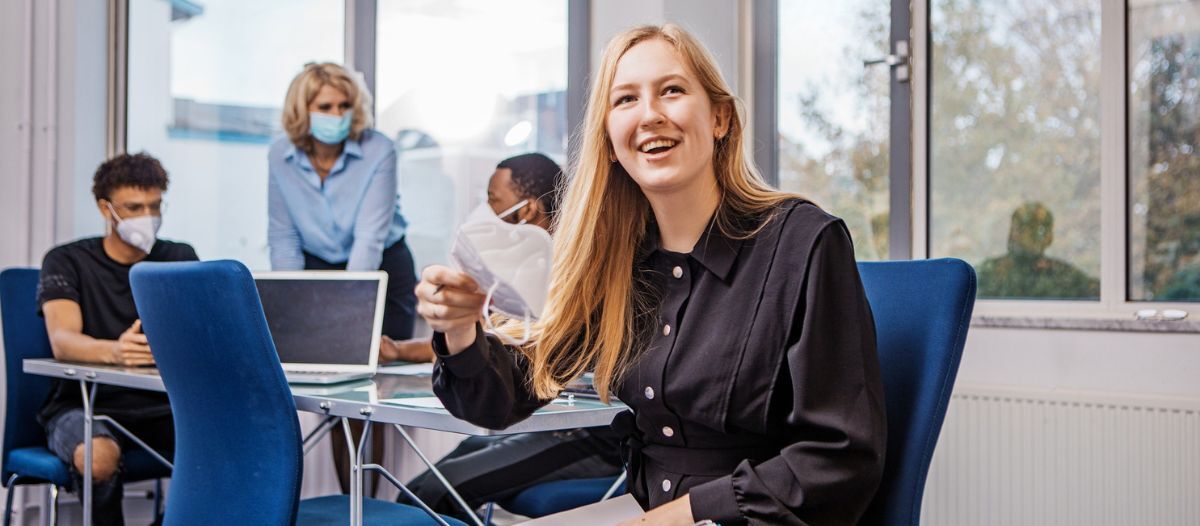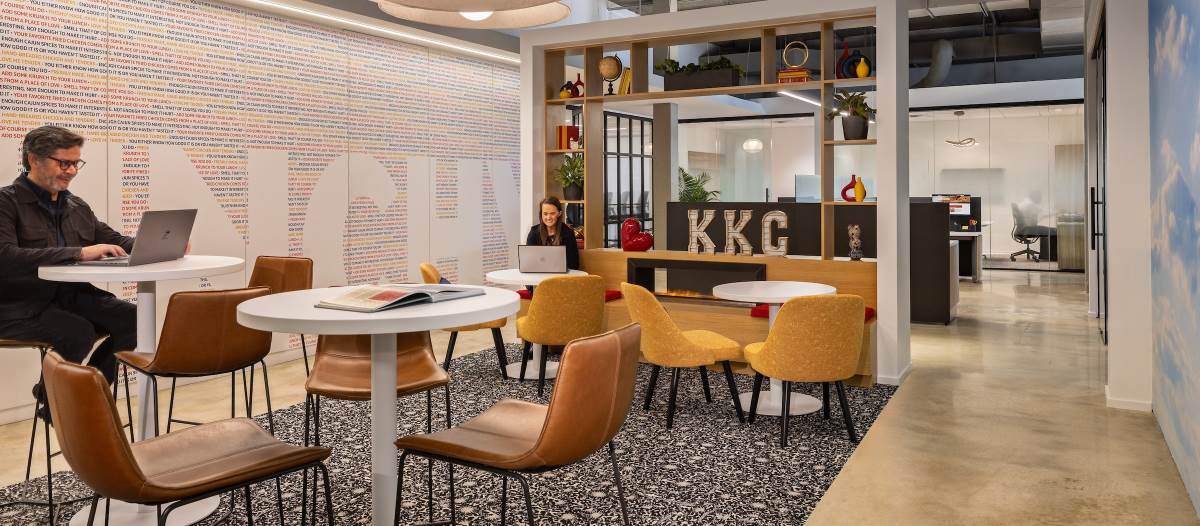Uncharted Territory
Navigating safety in a post-mask world

Thankfully, businesses have options to take greater control of their environments and offer safer, more comfortable spaces. A layered approach to safety is achievable with focus on ventilation and air cleaning as key elements of this transition. Installing technology that proactively kills viral aerosols rebalances the burden of safety from occupants protecting themselves to the building protecting its occupants. A century-old, gold standard technology for disinfection, germicidal UV light is being integrated into air cleaners that reduce risk of viral spread and boost the confidence of building stakeholders. Once a facility is armed to fight COVID-19, a freer, more lasting indoor environment is possible.
The science of the spread, simply stated
Many studies have shown, and the CDC has clearly stated, that the SARS-CoV-2 virus is transmitted through airborne viral aerosols.
The factors impacting the risk of contracting the virus are clear: the risk is higher in enclosed, crowded, under-ventilated spaces where people spend long periods of time.
According to the Centers for Disease Control and Prevention (CDC), infectious exposures to respiratory fluids carrying the virus occur in three main ways:
-
inhalation of air carrying small droplets and aerosol particles that contain infectious virus;
-
deposition of virus carried in exhaled droplets and particles onto exposed mucous membranes; and
-
touching mucous membranes with hands soiled by exhaled respiratory fluids containing virus or from touching inanimate surfaces contaminated with the virus.
Inhalation of airborne aerosols and direct deposition of droplets are the two primary routes of the transmission of SARS-CoV-2.
The risk of viral transmission is higher in under-ventilated indoor spaces where viral load can build to high levels. Exhaled viral aerosols can survive for hours in the air and can be subsequently inhaled by anyone sharing the space. Higher occupancy density and louder voices increase viral aerosol generation. Masks and lower occupancy density (social distancing) reduce the viral load added to the air. Masks can also reduce the viral load inhaled, which reduces the chance of becoming infected. Vaccines reduce the severity of the disease if someone becomes infected.
Masks offer protection, but are not a permanent solution
Masks, while effective, have their limits. For one, masks are not usable while eating and drinking. That is obvious in restaurants and bars but is also the case in cafeterias and breakrooms of schools and office buildings. Also, in many office spaces, employees do not wear masks when seated at their desks. Social distancing reduces the risk of direct impingement of droplets on a coworker's or classmate’s face, but exhaled aerosols still add to the air from across the room.
For children in schools, masks are not a permanent solution; prominent public health officials are now pressing school officials to develop plans and schedules for removing masks. In many communities, disagreements over masking have turned into violent confrontations. It is very clear that businesses and schools need other options to reduce risk while offering their customers, students, employees and building occupants a comfortable, safe and enjoyable indoor experience.
How to bring people back while managing risk
For schools and businesses, bringing students and customers back to establishments has naturally been a priority. But the dramatic changes in employee availability, wages and responsibilities require similar management attention and creativity. Many workers, especially in the food service sector, feel unsafe in their jobs or have left their jobs altogether. A recent private survey revealed the following insights:
- Almost 20 percent of restaurant workers do not feel safe at their own restaurants.
- Restaurant workers identified airborne virus as causing the highest risk to them at work.
- 100 percent of restaurant staff respondents would be more likely to continue working at their current place of employment if high-performance air purifiers that inactivated the virus were present.
Preventing more staff from leaving is a high priority for a wide range of businesses. Air cleaning and control technologies offer options to attract and retain staff, allow them to work efficiently and offload duties that are otherwise a distraction. As the pandemic goes through its seemingly relentless waves, technology enhancements will offer safer working environments, more productive employees and confident customers.
The opportunity to decrease the risk of airborne viruses is clear: flush the space with clean air through a combination of outdoor air ventilation and air cleaning.
Stopping the spread: A deeper understanding of COVID-19
It made sense that an initial response of many facilities - schools, restaurants, houses of worship - was to offer outdoor seating. Gathering outside (not in enclosed tents) offered an environment of far lower viral aerosol density than gathering inside a room with limited ventilation. The question remains, however, how to quickly and cost effectively create indoor air quality that is similar to that of outdoor air? How do these facilities implement the shifts needed to take indoor air quality to the next level? The good news is that the technology exists to make these upgrades quickly and efficiently.
Air cleaning technologies
Cleaning the air in each room with properly designed and sized air cleaners offers risk reduction with no loss of comfort, no additional limitations of behavior and no personal effort whatsoever. Detailed models that predict viral load reduction show that the proper use of air cleaners can lead to the same risk reduction as having room occupants all use cloth masks.
There are numerous air cleaning technologies available on the market:
Filters
-
In HVAC ductwork
-
In self-contained air cleaners
Germicidal Ultraviolet (UV) Light
-
In HVAC ductwork
-
In self-contained air cleaners
-
In upper room fixtures
How do these options compare?
Filters are very common. Filters work by collecting particulate material in the air that passes through the filter. Dust particles and other pollutants accumulate on the filter and, over time, reduce the ability of air to flow through the filter. Therefore, filters must be changed regularly.
Not all filters are the same; they are rated for their efficiency in removal of small particles. Viral aerosols are very small particles. Typical filters in HVAC ducting capture less than 20 percent of particles 0.3 – 1 micron in diameter. The coronavirus is smaller than 0.1 microns. The filters recommended for use in HVAC ducting to address the coronavirus, called MERV 13 filters, will allow 25 percent of particles 0.3 – 1 micron to pass through it.
A different category of air treatment equipment generates either ions or oxidizing molecules and blows those molecules into the air in a room. It is claimed that these ions or oxidizing molecules will deactivate microbes in the air. Products that generate and introduce molecules into the air are labeled by the EPA as emerging technologies, meaning that little research is available that evaluates its effectiveness outside of lab conditions.
The EPA and other agencies are quite clear that ozone and other reactive species generators should never be used in occupied spaces.
Another air cleaning system for viral or other microbial aerosols is germicidal ultraviolet (UV) light. UV light inactivates viruses, bacteria or molds so they cannot reproduce. Inactivation means that the DNA or RNA used to replicate the microbe is damaged. In this way, the virus or bacteria is killed. Once killed, the microbes can do no harm. With many UV air cleaners, there are no filters to clog or replace. Germicidal UV air cleaners kill, rather than collect, viral aerosols.
Compared to other available technologies, germicidal UV air cleaners represent a gold standard for sanitizing the air. The Israeli Ministry of Health recently certified specific air cleaners to address the spread of COVID-19. All of the certified air cleaners used germicidal UV.
Germicidal UV air cleaning for safer facilities
Air cleaners using germicidal UV are products that can be designed to kill more than 99 percent of viruses, bacteria, mold and other contaminants in indoor spaces. The UV systems do not require a filter, and therefore do not experience a decrease in air flow rate over time (as happens with filters as they fill up with contaminants.)
There are many reasons to kill virus with germicidal UV, rather than to collect and concentrate infectious aerosols in filters. Virions are very small and can pass through many grades of fine dust filters that are referred to in marketing material as HEPA. Buyers must be careful to determine if a filter called HEPA truly meets the HEPA filtration efficiency standard. Filters need frequent changing (every three months) because they fill with dust particles, causing the unit’s air flow rate to decrease over time. Filter change-out requires contact with filter material that has been collecting bioaerosols for months; this process provides the opportunity to release the material back into the room. Portable air cleaners using filters can be noisy. Many people purchase filter-type air purifiers with high capacity and operate them on low speed because they are so noisy. Low flow rates offer lower cleaning rates. Finally, filters located in HVAC ducting clean the air when there is a call for heat or cooling. Depending on how the HVAC system is configured, the air may not be continuously circulated or filtered.
The kill-rate of germicidal UV is highest with small aerosols like COVID-19. Self-contained, stand-alone units run continuously while the facilities are occupied. Occupants in the room can see the units operating and feel reassured of their safety. This is an important feature that cannot be provided by in-duct systems. Operated as recommended, the UV air purifiers require maintenance only every two years. Germicidal units are self-sanitizing, so there is no risk of virus transmission while servicing a unit. Finally, some UV-C systems operating in their ceiling mounts or floor mount cabinetry are very quiet at high speed, allowing the air to be cleaned at the full capacity of the air cleaner without causing distraction or annoyance.
How it works:
-
Air is pulled into the air cleaner; when ceiling mounted, the air is pulled up and away from occupants.
-
Virus, mold and bacteria in the air are killed/inactivated using germicidal UV light.
-
Purified air is returned to the space
-
No UV light is emitted into the room
The results:
-
Viral load in the air is killed
-
Airborne transmission is significantly reduced
-
No requirements imposed on customer or employee behavior
Conclusion
As FMs prepare for the future, in which SARS-CoV-2 infections will hopefully decrease but are unlikely to disappear entirely, it is crucial that they implement safety protocols that are both effective and livable. Indoor mask wearing will phase out, and new technological air cleaning solutions should be implemented. As always, a layered approach to safety is required. Installing stand-alone germicidal UV air cleaning in enclosed spaces improves the safety and comfort of indoor spaces, maintains employee satisfaction and protects buildings from future flu epidemics. It is a solid step in the direction of having buildings protect occupants, rather than the other way around.

Karen Benedek is CEO of Bluezone Products Inc., a manufacturer of air cleaning and fresh preservation systems, and managing partner of Primaira, LLC, a product development company amplifying innovation in the appliance, consumer and medical products industries. For more than 40 years, Benedek has advised companies and government agencies on strategic, market and technology issues related to energy, building systems and consumer products. Her focus has been in the application of advanced technologies to achieve safety and reliability enhancements, performance improvement, energy savings and emissions reduction. Benedek received her bachelor’s of science degree in mechanical engineering from Stanford University and her master’s of science degree in mechanical engineering from MIT.
References
nytimes.com/2020/07/04/health/239-experts-with-one-big-claim-the-coronavirus-is-airborne.html
cdc.gov/coronavirus/2019-ncov/science/science-briefs/sars-cov-2-transmission.html
https://www.who.int/emergencies/diseases/novel-coronavirus-2019/advice-for-public
nature.com/articles/d41586-021-00251-4
washingtonpost.com/opinions/2021/10/19/schools-should-do-away-with-mask-mandates-by-end-year/
yahoo.com/now/fight-over-mask-mandates-schools-203717693.html
Market Research Survey conducted for Bluezone Products Inc. by Perksy
Risk Assessment by Primaira, LLC “Infection Risk Reduction Using Bluezone Technology” using risk assessment tool based on research by Buonanno and Morawska (Buonanno G, Stabile L, Morawska L. Estimation of Airborne Viral Emission: Quanta Emission Rate of SARS-CoV-2 for Infection Risk Assessment. Environment International. https://doi.org/10.1101/2020.04.12.20062828.)
epa.gov/coronavirus/air-cleaners-hvac-filters-and-coronavirus-covid-19
health.gov.il/UnitsOffice/HD/InfectionControl/Documents/Air-enclosed-spaces-Summary.pdf
Read more on Occupancy & Human Factors , Risk Management and Real Estate
Explore All FMJ Topics









